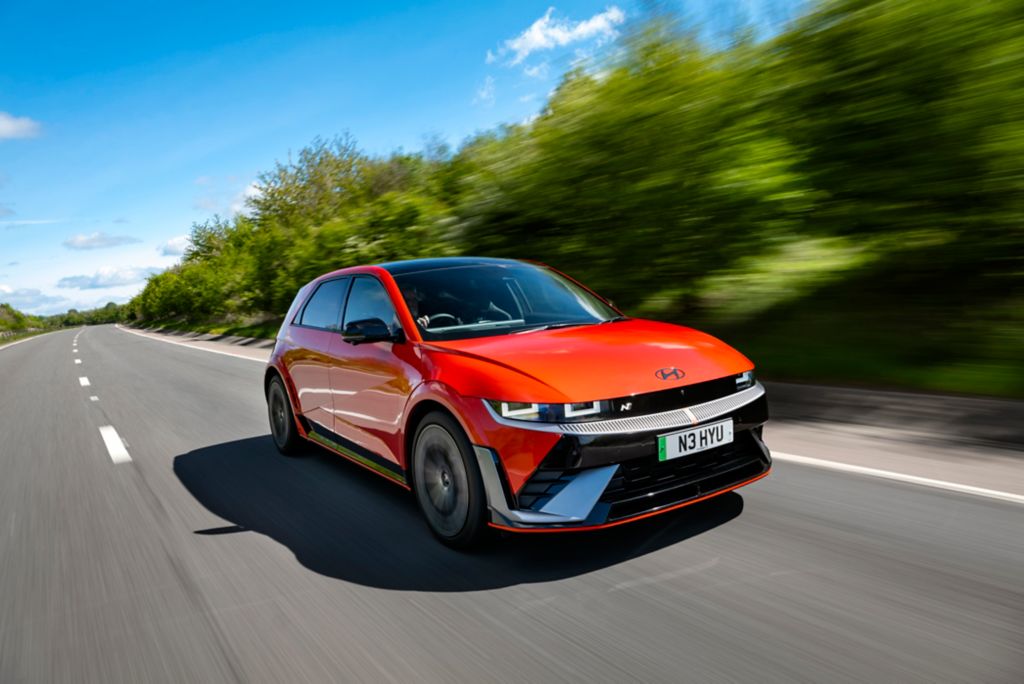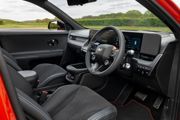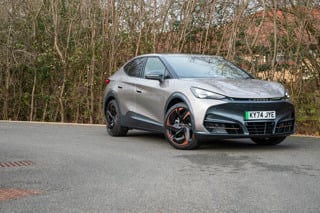Review
Electric vehicles have evolved significantly in the last decade and the main focus for manufacturers has been to deliver cars that can match the convenience of their petrol or diesel-powered counterparts.
Models with ranges of 300 miles and ultra-fast charging are becoming a reality and Hyundai is among the car brands at the forefront of that development.
But it has also been working on other ways to make electric cars more like those with internal combustion engines. Ways in which no other car brand has managed, or even attempted.
What we’re looking at here is the electric car v2.0. The new benchmark. A completely unique vehicle that is like nothing else with a battery.
It’s the Ioniq 5 N. It may seem a little superfluous to be discussing yet another performance EV. Most manufacturers are now sticking their ‘sporty’ badges on electric cars and ramping up the horsepower to ridiculous levels in a bid to nail the fastest 0-60 acceleration times.
Everyone from MG, with the MG4 XPower, right up to Porsche with its Taycan ‘Turbo’ are up to it.
Hyundai’s sister company, Kia, even makes a ‘hot’ EV6. But, let's face it, most of them are being sold as company cars.
They all sit at the feet of the Ioniq 5 N, however.
We’ll start with the basics. Hyundai’s N-division usually makes hot-hatch versions of cars like the i20 and i30. They’re impressive machines that compete well with their competitors.
With the Ioniq 5, they’ve done plenty of things that you’d expect. There’s a body kit, for a more aggressive look. Lowered suspension and larger wheels. Massive brakes and bucket seats. Yes -we’ve seen it all before, right?
Wrong. What makes the Ioniq 5 N so special is not what you can see. It’s what you feel, what you hear and the fact that it all comes without any real compromises on what was already a decent EV.
Under the skin the car has been massively overhauled. Just about everything that connects the car to the road has been breathed on. But the IT geeks have also had a field day.
Power from the car’s two motors has been upped to 650PS. In the grand scheme of things, that’s not really very impressive these days. But the way the motors deliver this power is frankly astonishing.
“It’s got….. gears?”, I loudly exclaimed as I pulled onto a main road for the first time. It sounds ridiculous, but it’s true. Well, it doesn’t actually have gears. It has a very clever software calibration that perfectly replicates ‘shifts’. When combined with the car’s synthesized engine sound, you’d be extremely hard pressed not to believe that there was a twin-clutch autobox sending power to the wheels. It’s that good.
After driving the car for a couple of hours, I actually had to ask a representative from Hyundai “it doesn’t actually have gears, right?”.
Of course it doesn’t. And I know you’re probably thinking that this is some kind of gimmick that’s only going to appeal to young kids. Trust me. It really does work.
When you add in some sound and the feeling of the car shunting through its eight speeds – it does this with differing intensity depending on how hard you’re ‘revving’ it – the visceral experience is so much better than the usual, silent, neck-snapping surge from anything else.
What’s more, when you take manual control, using the steering wheel paddles, the power delivery is adjusted to suit the ‘gear’ you’re in. Try and pull off in fourth and it bogs down, leave a shift too late and it hits a rev limiter.
The excitement continues when you reach a corner. Despite weighing 2.2 tonnes, the handling is excellent. It’s a real marvel in the corners and that doesn’t even come at the expense of ride quality. Set the dampers to their softest setting and the car glides along unruffled.

Hyundai gives the driver a massive amount of customisation, to dial in the car exactly to their preference. It has the usual ‘Normal’, ‘Sport’ and ‘Eco’ modes that all Ioniq 5’s have, but then there’s ‘N-Mode’. Activated by a special button on the steering wheel, drivers can toggle between two ‘N’ calibrations. You can set everything from powertrain, suspension, steering, and traction control, to what noise the car makes when you hit the accelerator.
On the other side of the steering wheel is the switch for N e-shift , which is the synthesized gears. Switch them off and the Ioniq 5 N returns to being a ‘regular’ EV.
That’s the beauty of this car. It gives you choice. In Normal mode it can waft around silently, like any other electric car. The throttle response is actually quite restrained in this mode, making it perfect for long business trips. But one flick of the N button and the engine sound fills the cabin, the suspension stiffens, and the car comes alive.
The mighty power output means 0-62mph is dealt with in 3.4 seconds. But, really, if the car had half as much power it would be just as fun.
When it comes to range, it’s another round of good news. WLTP suggests 278 miles is possible. We managed to eke the efficiency figure up to a respectable 3.0mi/kWh, despite some spirited driving. In reality, it’s probably good for about 240 miles, possibly more if you’re particularly careful.
There are a few shortcomings, naturally. For starters, the sporty seats are manually adjustable and don't offer a great amount of adjustment. Also, the amount of customisation is a little baffling. There's multiple layers of menus to adjust the myriad of settings.
Hyundai has priced the Ioniq 5 N at £65,000, which makes it exceedingly good value when you factor in everything the package offers. Right now it’s the only EV that gets anywhere close to matching a petrol hot-hatch. Factor in the 2% benefit-in-kind tax charge and it’s difficult not to view the Ioniq 5 N as a serious contender.
Matt has been an automotive journalist for nine years and has driven just about every new car and van that's on sale. As content editor - vehicles he is responsible for the automotive content on Fleet News and also contributes to Automotive Management. Prior to this, Matt worked in the automotive industry for 10 years.


Specs
| Manufacturer | Hyundai |
| Model | Ioniq 5 N Electric Hatchback |
| Specification | Hyundai Ioniq 5 N Electric Hatchback 478kW 84 kWh 5dr Auto |
| Model Year | 2025.00 |
| Annual VED (Road tax) | £10 |
| BIK List Price | £64,945 |
| Range | 278.00mile(s) |
| CO2 | N/A |
| BIK Percentage | 3% |
| Insurance Group | N/A |
| CC | 1 |
| Fuel Type | Electric |
| Vehicle Type | Medium car |
| Luggage capacity (Seats up) | 480litres |
| Doors | 5 |
Running Costs
| P11D | £64,945 |
| Cost per mile | 64.46ppm |
| Residual value | £29,600 |
| Insurance group | N/A |
| Fuel Type | Electric |
| Cost per mile | 198.72ppm |
| Fuel | 3.07ppm |
| Depreciation | 193.25ppm |
| Service maintenance and repair | 2.40ppm |
Rivals
Info at a glance
-
P11D Price
£64,945
-
MPG
N/A (WLTP) -
CO2 Emissions
N/A -
BIK %
3% -
Running cost
3 Year 60k : £29,600 4 Year 80k : £24,100 -
Fuel Type
Electric -
Range
278.00mile(s)



































Login to comment
Comments
No comments have been made yet.